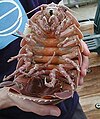The Crustaceans Portal Crustaceans (from Latin meaning: "those with shells" or "crusted ones") are invertebrate animals that constitute one group of arthropods that are a part of the subphylum Crustacea (/krəˈsteɪʃə/), a large, diverse group of mainly aquatic arthropods including decapods (shrimps, prawns, crabs, lobsters and crayfish), seed shrimp, branchiopods, fish lice, krill, remipedes, isopods, barnacles, copepods, opossum shrimps, amphipods and mantis shrimp. The crustacean group can be treated as a subphylum under the clade Mandibulata. It is now well accepted that the hexapods (insects and entognathans) emerged deep in the Crustacean group, with the completed pan-group referred to as Pancrustacea. The three classes Cephalocarida, Branchiopoda and Remipedia are more closely related to the hexapods than they are to any of the other crustaceans (oligostracans and multicrustaceans). The 67,000 described species range in size from Stygotantulus stocki at 0.1 mm (0.004 in), to the Japanese spider crab with a leg span of up to 3.8 m (12.5 ft) and a mass of 20 kg (44 lb). Like other arthropods, crustaceans have an exoskeleton, which they moult to grow. They are distinguished from other groups of arthropods, such as insects, myriapods and chelicerates, by the possession of biramous (two-parted) limbs, and by their larval forms, such as the nauplius stage of branchiopods and copepods. Most crustaceans are free-living aquatic animals, but some are terrestrial (e.g. woodlice, sandhoppers), some are parasitic (e.g. Rhizocephala, fish lice, tongue worms) and some are sessile (e.g. barnacles). The group has an extensive fossil record, reaching back to the Cambrian. More than 7.9 million tons of crustaceans per year are harvested by fishery or farming for human consumption, consisting mostly of shrimp and prawns. Krill and copepods are not as widely fished, but may be the animals with the greatest biomass on the planet, and form a vital part of the food chain. The scientific study of crustaceans is known as carcinology (alternatively, malacostracology, crustaceology or crustalogy), and a scientist who works in carcinology is a carcinologist. (Full article...) Selected article
Potamon fluviatile is a freshwater crab found in or near wooded streams, rivers and lakes in Southern Europe. It is an omnivore with broad ecological tolerances, and adults typically reach 50 mm (2 in) in size during their 10–12 year lifespan. They inhabit burrows and are aggressive, apparently outcompeting native crayfish. P. fluviatile has been harvested for food since Classical antiquity, and is now threatened by overexploitation. Many of the island populations are particularly vulnerable, and the Maltese subspecies has become a conservation icon. A population in Rome is the only population of freshwater crabs to occur in the middle of a large city, and may have been brought there before the founding of the Roman Empire.
Did you know?
Selected biography
Charles Robert Darwin FRS (February 12, 1809 – April 19, 1882) was an English naturalist who established that all species of life have descended over time from common ancestors, and proposed the scientific theory that this branching pattern of evolution resulted from a process that he called natural selection. In 1846, Darwin returned to a fascination in marine invertebrates, dating back to his student days with Robert Edmond Grant, by dissecting and classifying the barnacles (Cirripedia) he had collected on his voyages. In the following eight years of work on barnacles, Darwin's theory of natural selection helped him to find homologies, showing that slightly changed body parts served different functions to meet new conditions, and in some genera he found minute males parasitic on hermaphrodites, showing an intermediate stage in the evolution of distinct sexes. In 1853, this work earnt Darwin the Royal Society's Royal Medal, and it made his reputation as a biologist. Even without publication of his works on evolution, Darwin would have had a considerable reputation as the author of The Voyage of the Beagle, as a geologist who had published extensively on South America and had solved the puzzle of the formation of coral atolls, and as a biologist who had published the definitive work on barnacles.
Selected image Periclimenes imperator (Decapoda: Palaemonidae) is a species of shrimp with a wide distribution across the Indo-Pacific that lives commensally on a number of hosts, including the sea slug Hexabranchus. General imagesThe following are images from various crustacean-related articles on Wikipedia.
Crustacean lists
SubcategoriesRelated portalsWikiProjectsAssociated WikimediaThe following Wikimedia Foundation sister projects provide more on this subject:
Discover Wikipedia using portals
|






















































